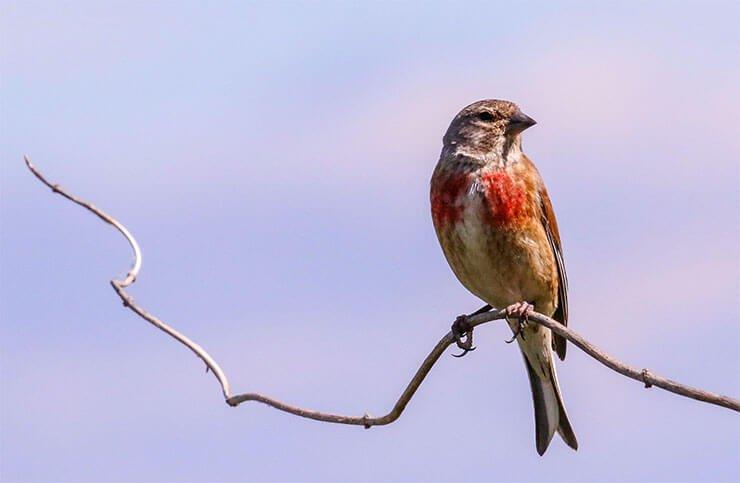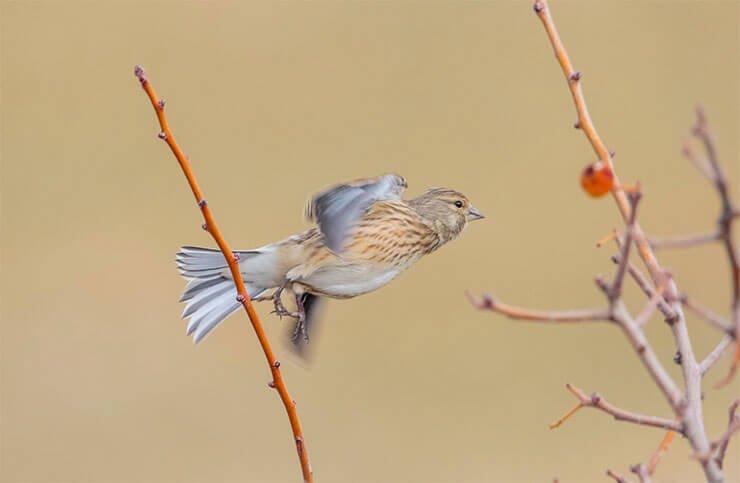During the winter, the species remains in the meadows, in numerous flocks, or in the open field, where it ventures between hedges and rows, in search of seeds or some insects. Clearly gregarious habits that the species sometimes maintains even during the reproductive period, when it nests “in society” among the dense vegetation, bushes and hedges. With a particularly melodic call, it is often captured for breeding in captivity and is sometimes hybridized with the canary.
Unlike many other species of birds, during the reproductive period, the linnet, unremarkable, does not have a feeding place. But instead, it collectively uses surfaces with a decent amount of food available, such as mowing the lawn. The nesting bird usually covers and protects an area of about 15 meters around the nest. This limit is respected and neighboring pairs avoid getting too close. The male enjoys hanging from the branches around where the nest is located, showing off high in a bush or on some higher ground. With this, it marks its nesting territory which, together with the female, it defends even from other species of birds.
It is a gregarious species in winter. It usually moves in groups looking for food both on the ground and in tall grasses and bushes, often in small groups. Due to its small size it is not easy to identify it, especially when it is placed on the ground. Things are simplified when it is in flight (wavy and not fast) to later recognize it from other species of similar size, especially by the white wing bar and white outer hooves. It is a very active species and in constant movement.
Fast facts:
The summer-dressed male has tawny shoulders and back and the terminal part of the wings is blackish with a shadowed white area visible even when the subject is perched. The head is gray with a red tip and the throat tinged with white. The breast is red/pink fading to dirty white on the abdomen and a tinged fawn color on the sides. The legs and beak are sometimes gray with fawn tones. The tail is blackish with a white outer helm.
In winter, the male assumes a color on all upperparts of a fawn brown with the head of a lighter brown and the red disappearing from the head and almost completely from the breast. All underparts are fawn white with light brown flecks on the sides. The beak is dark yellowish. Females resemble males in winter dress, but exhibit a blackish-gray bill and slightly thicker stripes on the sides and breast; the white area of the wing is much fainter. Juveniles look almost exactly like the winter-dressed male.
The linnet’s habitat extends to many areas of Europe, Asia and Africa. At least seven different subspecies have been counted, and the nominal species (Linaria cannabina cannabina) is also called the Eurasian linnet to distinguish it from the others more widespread in Africa or on the islands (Balearic Islands, Canary Islands, Corsica).
Like all granivorous birds, the linnet feeds mainly on seeds, but also on insects.
It usually nests in bushes near streams, laying up to 4-6 bluish-white eggs, dotted with light brown at the ends, for a maximum of two clutches annually. The incubation of the eggs lasts about 13 days and the chicks are ready to fly already 15 days after hatching, although they will have to wait a couple of weeks until they are completely weaned.
Classified as declining in the European Union, the linnet has an unfavorable conservation status even at continental level. In general, there is stability of the breeding population in the European Union in the period 1970-1990, followed by a moderate decline in the period 1990-2000.
Currently, the breeding population in the EU is estimated at 5,000,000-13,000,000 pairs, which is approximately half of the continental population of the species (10,000,000-28,000,000 pairs) and a fraction between 25 and 49% of the world population of the species. The Italian population appears stable and is estimated at 100,000-400,000 pairs, which is equivalent to 2-3% of the EU community population and just over 1% of the total continental population.
To improve the species’ prospects, it is essential to promote the maintenance of traditional agricultural landscapes in mountain areas with non-intensive agriculture and grazing. The maintenance of marginal elements such as small vacant bushes, hedges and small trees or isolated bushes in cultivated or grazed areas should also be encouraged, limiting the use of pesticides in orchards and crops frequented by the species.
To date it is particularly likely that the health status of populations is more favorable at higher altitudes, while at lower altitudes the combined effect between the abandonment of traditional agricultural practices, the consequent advance of forests, the massive use of pesticides in areas subject to intensification of agricultural practices, it has probably led to a significant reduction of suitable habitat.









